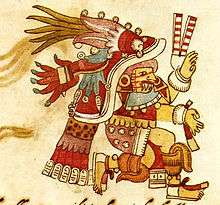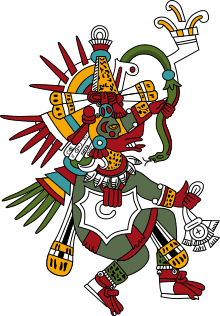Chantico

In Aztec religion, Chantico ("she who dwells in the house") is the deity reigning over the fires in the family hearth. She broke a fast by eating paprika with roasted fish, and was turned into a dog by Tonacatecuhtli as punishment.
Etymology
Texts from the informants of Bernardino de Sahagún affirm Chantico's name to mean "she who dwells in the house" or "she who comes to make the house." [1] Chantico is also said to also have been called Quaxolotl and nicknamed Chiconaui [2] Alternate spellings of Chantico include Cantico. [3]
Origin Narrative
According to the Codex Vaticanus A, also known as Codex Rios, Tonacatecuhtli turned her into a dog when she broke fast during a religious celebration by eating roasted fish and paprika, leading her to gain the name "Nine Dogs." Those born on the ninth day of eighteenth trecena, over which Chantico presided over, would face encounter misfortune since that day was associated with sorcerers, said to shape-shift into a number of animals. [3]
History
Chantico was associated with the town of Xochimilco. According to texts from the informants of Bernardino de Sahagún, Chantico was worshipped in the twenty ninth building of Templo Mayor. [1]
Iconography

In Codex Borgia, Chantico is depicted as having a yellow face marked with two red lines, which designate her as a fire goddess, and a yellow body. She is referred to as "muger amarilla" ("yellow woman"). She is depicted sitting on a chair, under which a flask lies, and wearing a nose ornament known as a yacapapalotl. The Codex Borgia also depicts Chantico, who was associated with warriorship, through an eagle foot covered in jaguar skin, a symbol of Chantico, sitting on top of a sacrificial blood-dish, alluding to warrior sacrifice.[4][5]

Sahagún and his informants describe Chantico by stating
"She has a bulge of rubber on her lips, half of her face painted red, a bouquet made of dried herbs, her gold ear decorations. On her back she carries a bundle of light. Her shirt with water flowers. Her shield with mosaic of eagle feathers, She has her clothes in one hand that ends in a tip, made of inverted feathers and with paint of obsidian tips. Her white kilt, her bells, her white sandals"
-Bernardino de Sahagun, "Ritos, sacerdotes, y atavíos de los dioses" [1]
Chantico’s headdress displays military attributes: a crown of poisonous cactus spikes, related to danger and aggression; a crest of aztaxelli, green warrior’s feathers, connecting her with warfare. At the nape of her neck is a band that forms the alt-tlachinolli, or water-fire, a symbol for warfare and pestilence. From her head flows a stream of blue water intertwined with red fire. Chantico possesses both masculine and feminine qualities. She wears a man’s loincloth, bordered with eagle feathers, in addition to a female’s skirt, which is black and decorated with bundles of white down feathers. Her earrings are fashioned from circular, trapezoidal, and triangular forms. Chantico also wears a skull back-buckle. She is seen with the teeth of a dog.
Debates
Gender
Although most commonly referred to as a female deity, the gender of Chantico remains unclear in certain historical writings. For example, the Codex Rios presents ambiguous pronouns, stating
Cantico they say was the first who offered sacrifice after having eaten a fried fish; and that in consequence of the presumption of offering sacrifice without having fasted, Tonacatecuhtli became incensed, and pronounced a curse against him (her), that he (she) should be changed into a dog, which is an animal of a very voracious nature; and accordingly they named him (her) Nine Dogs. He (she) presided over these thirteen signs. They said that he who was born on the first sign of Air (Wind) would be healthy by his nativity; but that if he grew ill of pains or cancer, that his disease would be incurable. He who was born on the ninth sign they believed would be unfortunate, because that sign was dedicated to sorcerers and necromancers, who transformed themselves into the shapes of various animals [3] -Codex Rios
The Kingsborough commentary on the Codex Telleriano-Remensis on the gender of Chantico also utilizes male pronouns, referring to Chantico as "the lord of chile or the yellow woman."[2]
Gallery
 Chantico (right) depicted in Nahuatl codex Aubin Tonalamatl
Chantico (right) depicted in Nahuatl codex Aubin Tonalamatl
References
- 1 2 3 Sahagún, Bernardino de (1958). Ritos, Sacerdotes, y Atavíos de los Dioses. Mexico: Universidad Nacional Autonoma de Mexico. p. 149.
- 1 2 Howard, Marshall (1922). Turquois mosaic art in ancient Mexico. New York: Museum of the American Indian. pp. 35–36.
- 1 2 3 famsi. "FAMSI - John Pohl's - Ancient Books - The Borgia Group - Codex Rios". www.famsi.org. Retrieved 2018-10-07.
- ↑ Seler, Eduard (1902). Codex Vaticanus 3773. Berlin and London. pp. 273–278.
- ↑ "Codex Borgia". Digital Vatican Library.
